New semester, new efforts to fight student hunger
A basic needs manager, center and website will debut in 2018-19, and a big new push for CalFresh is on
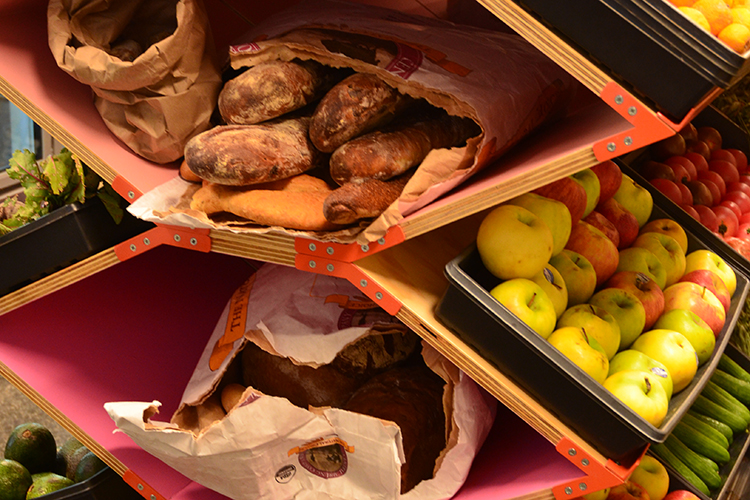
August 15, 2018
As nearly 42,000 students begin lugging college basics like backpacks, laptops and books to UC Berkeley for fall semester, the campus is unveiling new plans to arm all students with an even more basic necessity — healthy, affordable food.

The food pantry’s layout, shelving and storage units recently were redesigned by emBARC, a four-week summer design program at the College of Environmental Design for high school students. (UC Berkeley photo by Gretchen Kell)
A successful push last year to start helping an estimated 10,000 Berkeley students in need to sign up for CalFresh, a federally funded program that issues a free debit card for groceries to those who qualify, is intensifying, with a goal of 3,000 students applying in 2018-2019.
Across the UC system, 44 percent of undergraduates and 26 percent of graduate students say they are food insecure, meaning they experience reduced food intake or disrupted eating patterns at times due to a lack of money and other resources, according to a report from the UC Global Food Initiative.
“We’re going all out on CalFresh,” says Ruben E. Canedo, food/basic needs co-chair of the UC-wide initiative and chair of the UC Berkeley Basic Needs Committee.
Meanwhile, the UC Berkeley Food Pantry, which has seen a tenfold increase in traffic since 2016, was redesigned this summer to better accommodate the 3,000 students who collectively visit the pantry 22,000 times a year.
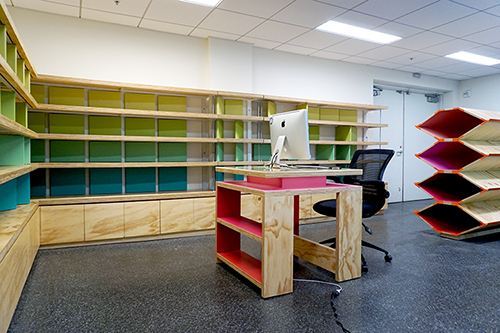
New, modern shelving in rainbow colors was created for the pantry this summer in the College of Environmental Design’s Fabrication Shop. (CED Fabrication Shop photo)
The campus’s first full-time basic needs manager arrives on Sept. 10, and in December, a new basic needs center is scheduled to open in the Martin Luther King Jr. Student Union, next to the pantry. A new basic needs website is launching later in the school year, and there also are plans to pilot a food recovery model to prevent food waste.
“Students at Berkeley have a unique grit — it’s cutthroat here, and everyone’s doing 10 things on top of academics. But it’s also a tough physical environment, with high rent, which can lead to basic needs insecurity,” says CalFresh campus coordinator Vikrem Padda, a senior majoring in geography. “We shouldn’t normalize this situation — it’s not OK to be stressed and hungry all the time. These new services will offer students more support.”
A strong CalFresh alliance
A partnership the campus has built with Alameda County Community Food Bank and Alameda County Social Services has led to a “skyrocketing” in the number of student sign-ups for CalFresh, a nationally underutilized program — known outside California as SNAP — that needs more visibility, says Liz Gomez, director of client services at the county’s food bank, which runs the program on campus.

The UC Berkeley Food Pantry receives fresh produce from the Gill Tract, Oxford Tract, Clark Kerr campus gardens and various farmer’s markets in the Bay Area. (UC Berkeley photo by Gretchen Kell)
Two years ago, Berkeley students submitted 216 applications to CalFresh, which provides up to $192 in benefits a month on a free EBT (electronic benefit transfer) card to most eligible individual college students. Last year, that number grew to 1,366, and this school year, the goal is 3,000.
Last November, Berkeley became the first UC campus to host a CalFresh “mega clinic” — a five-hour event for almost 200 students. In Pauley Ballroom, students received CalFresh application support from staff at the county food bank and explored a resource fair showcasing the many stores, farmer’s markets and services that accept the CalFresh EBT card.
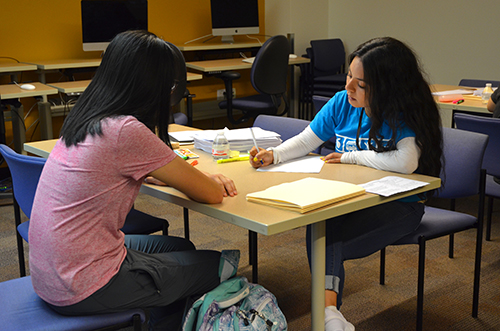
Outreach associate Crystina Esparza (right) helps a student sign up for CalFresh benefits in the Unit 1 residence hall at Golden Bear Orientation. (UC Berkeley photo by Gretchen Kell)
This summer, CalFresh webinars for targeted incoming students were held by the campus, the county food bank and county social services, and additional students watched the webinar video and can register this week for CalFresh during special sessions being held during Golden Bear Orientation. Upcoming sessions will take place Aug. 14, 20 and 21 from 9 a.m. to 5 p.m. in Unit 1‘s All-Purpose Room and Aug. 16 and 17 from 10 a.m. to 5 p.m. in the Multicultural Community Center. Students also can sign up via tinyurl.com/1819calfresh.
Canedo is exploring opportunities to jointly hold customized CalFresh sessions with campus programs and departments that have high numbers of students who typically are the most eligible for CalFresh — recipients of a Cal Grant A or B or a Pell Grant, those eligible for federal work study jobs and students from populations that historically experience basic needs insecurity.
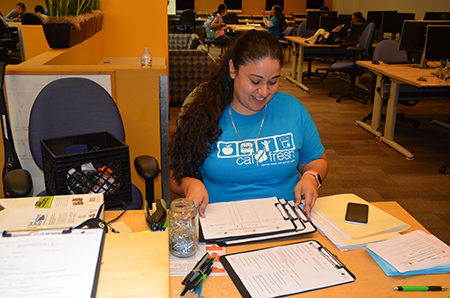
Berkeley alumna Vanessa Ramirez, now an outreach coordinator for the Alameda County Community Food Bank, greets students at the Aug. 13 CalFresh session in Unit 1. (UC Berkeley photo by Gretchen Kell)
Additionally, he aims to up the percentage of student applications that county social services approves. Currently, it’s 70 percent, compared to 50 percent nationwide. But Canedo says the rate jumped to 94 percent when county eligibility workers were invited to campus last spring during finals week to hold on-the-spot, face-to-face interviews with student applicants.
“One of the biggest reasons why applications are denied,” says Gomez, “is because the required phone interview between college students and eligibility workers is not completed. Maybe the student was in class, or the appointment was missed, or paperwork wasn’t submitted.”
Monthly meetings that are bringing together key campus, county food bank and county social services representatives “allow us to talk about problems and solutions,” she adds. “It takes a village to make a difference, and we have the right people around the table.”
Food isn’t the only solution
Stella Zhu, the campus food pantry’s student coordinator, says that although the pantry’s visibility is increasing, “it still may be under-serving those who need it. I meet people every day who tell me they’ve been skipping meals because they’re trying to save money, and they’re surprised to hear we have a campus pantry.”
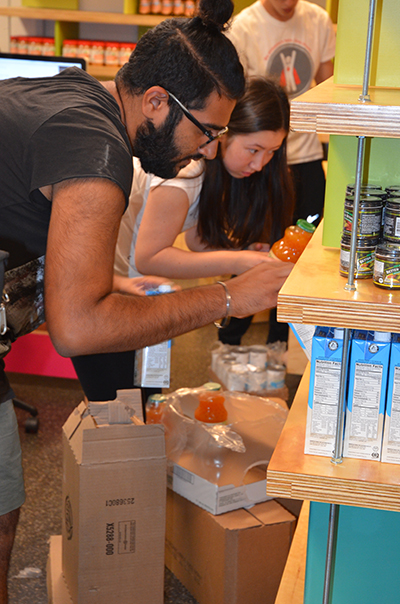
CalFresh campus coordinator Vikrem Padda helps stock shelves at the food pantry. (UC Berkeley photo by Gretchen Kell)
But students need more than the pantry, which can only provide limited food relief, adds Zhu, a senior majoring in sociology and molecular and cell biology. The five non-perishable items, such as peanut butter, pasta sauce and cereal, that students can pick up twice a month, “shouldn’t be the only solution for such a widespread, systemic issue.”
The upcoming opening of the new 3,875-square-foot basic needs center, next to the pantry, will help students more easily discover all the support and opportunities available to them, including basic needs skills development workshops, help applying for CalFresh or the campus’s Food Assistance Program, case management for students in various stages of homelessness, crisis resolution and community organizing opportunities.
She emphasizes the strain that insecurity about food and housing puts on students’ mental health when they’re also trying to navigate a stressful academic environment.

Ruben Canedo, chair of the UC Berkeley Basic Needs Committee, says it’s time for “going all out on CalFresh.” (UC Berkeley photo by Hulda Nelson)
Students struggling with all this are “incredible and brave,” she says, “but you shouldn’t have to worry about if you will eat today, or if your meal is nutritious enough to give you energy to write that 10-page paper. Or if you even have a bed to go to after a long day of class.”
“You come to Berkeley,” she adds, “because you have ambitious academic goals. But higher education has become inaccessible and unaffordable for many. The campus should support these aspirations by prioritizing students’ mental health and physical well-being” and by innovating to create affordable student housing options and other barrier breakers.
A recently published study in the Journal of Health Psychology examined the relationships among food insecurity, mental health and academic performance for California college students and found that “if you experience food insecurity, you’re more likely to experience poor mental health and a lower GPA,” says author Suzanna Martinez at the Nutrition Policy Institute. The institute is housed within the UC’s Division of Agriculture and Natural Resources and was formerly the Atkins Center for Weight and Health at UC Berkeley.
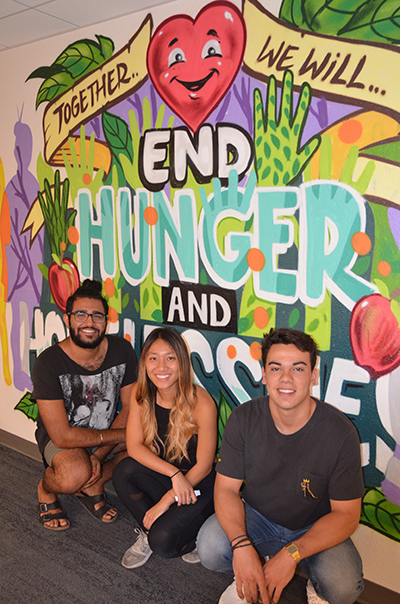
From left, Vikrem Padda, CalFresh campus coordinator, and basic needs security food systems co-coordinators Stella Zhu and Ibrahim Menendez in front of a mural that says “Together we will end hunger and homelessness.” (UC Berkeley photo by Gretchen Kell)
“These findings are in line with what students have expressed in focus groups we have conducted. They told us, ‘When I don’t have food to eat, I can’t think,’” says Martinez. “They feel food insecurity impacts their academic performance, the main reason they’re here (on campus).”
The report recommends that universities devise strategies and actions to identify students at risk of food insecurity and connect them with campus services and complementary federal, state and local programs.
Canedo says this work must include fundraising, since the state, which gave the UC system $2.5 million last year — $250,000 for each campus — for basic needs work, has reduced the amount per campus to $150,000 for 2018-2019.
“It’s a priority this year to strategize partnerships and donations for sustainable funding,” he says. “This was a record year for students served.”
Information about how to donate to basic needs security at Berkeley can be found online.